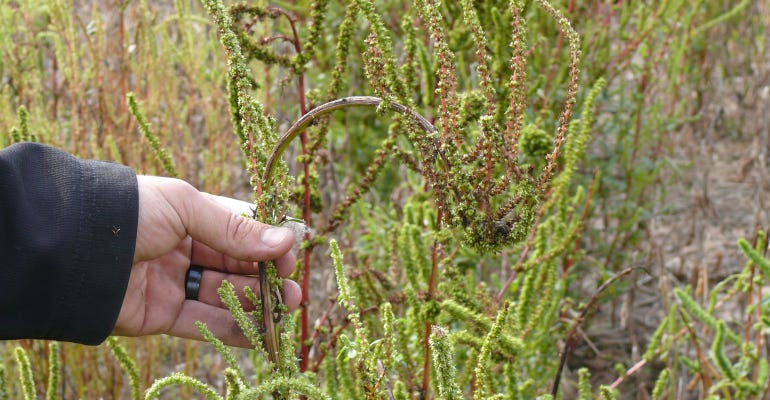
There is one key point to remember about the toughest members of the pigweed family, Bill Johnson says. The Purdue University Extension weed control specialist includes tall waterhemp and Palmer amaranth in that category.
The key? Both creep up when you least expect it. If you’re not vigilant all season, they may literally lurk in the shadows of the crop canopy, producing seed. Combines spread seeds. Palmer amaranth is also often spread on dairy farms when it hitches a ride north in cottonseed meal, and then goes out through the manure spreader.
Tall waterhemp moved eastward from Western states. It may be on your farm, whether you know it or not. Palmer amaranth came up from Southern states. While its arrival was heralded before tall waterhemp, it hasn’t spread as quickly as some thought it might; but it’s still here and deserves watching, Johnson says.
Tall waterhemp
“Since each [waterhemp] plant can produce many seeds, the population can blow up in a hurry,” Johnson says. “You don’t think it’s on your farm, and then one year it’s everywhere. It was likely in the field as scattered plants, and you didn’t identify it. It typically isn’t blown in or moved by wind. It’s more likely spread during harvesting.”
In Indiana, waterhemp was in 32 of 92 counties in 2016. Johnson believes it’s in at least 50% more counties now, and that might be conservative. It’s more prevalent down the western side of Indiana, but is present in central, east-central and southeastern Indiana, too.
One farmer in 2018 was surprised waterhemp exploded in corn for the first time on his farm. Another farmer was confident he didn’t have it until he walked soybeans with an agronomist and found a few plants. “A few is all it takes,” Johnson says. “I recommend he assume it’s present when he prepares weed control for corn.”
Assume waterhemp is glyphosate- and ALS-resistant, Johnson says. If Flexstar, Cobra or Blazer don’t control it, it’s likely also PPO-resistant.
Waterhemp tends to perform best in years with ample to excess moisture. It can produce seed late into the year.
Palmer amaranth
The Southern giant Palmer amaranth has shown up most often in north-central Indiana, but it’s also been identified in other scattered areas. It appears to prefer drier, warmer growing conditions.

SEEDS GALORE: Note the length of the seed heads on these Palmer amaranth plants. Producing seed is what these plants do best.

“We were starting to get calls when May was warm and dry in 2018,” Johnson says. “When the weather pattern changed, it didn’t turn out to be a particularly bad year for Palmer amaranth.
“However, 2018 was a good reminder that it’s still here. If you know you have it on your farm, design weed control programs with Palmer amaranth in mind. You can’t afford to ignore it.”
That’s because of two factors, Johnson says. First, once Palmer plants are 4 inches tall or taller, they’re virtually impossible to control with most postemergence herbicides. And they can grow from 2-inch plants to weeds larger than 4 inches in just a few days when conditions are right. Secondly, they also produce a tremendous amount of seed, and can keep producing seed until late in the year.
About the Author(s)
You May Also Like




